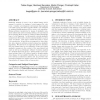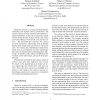MSR
2006
ACM
14 years 6 months ago
2006
ACM
Similarity analysis of source code is helpful during development to provide, for instance, better support for code reuse. Consider a development environment that analyzes code whi...
AOSD
2006
ACM
14 years 6 months ago
2006
ACM
OOP style requires programmers to organize their code according to objects (or nouns, using natural language as a metaphor), causing a program’s actions (verbs) to become scatte...
WCRE
2006
IEEE
14 years 6 months ago
2006
IEEE
Current literature on the topic of duplicated (cloned) code in software systems often considers duplication harmful to the system quality and the reasons commonly cited for duplic...
SP
2006
IEEE
14 years 6 months ago
2006
IEEE
Many current systems allow data produced by potentially malicious sources to be mounted as a file system. File system code must check this data for dangerous values or invariant ...
SIPS
2006
IEEE
14 years 6 months ago
2006
IEEE
Low-Density Parity-Check (LDPC) codes have been adopted in the physical layer of many communication systems because of their superior performance. The direct implementation of the...
ICPPW
2006
IEEE
14 years 6 months ago
2006
IEEE
In retargeting loop-based code for multimedia instruction set extensions, a critical issue is that vector data types of mixed precision within a loop body complicate the paralleli...
AICCSA
2006
IEEE
14 years 6 months ago
2006
IEEE
Poorly designed software systems are difficult to understand and maintain. Modifying code in one place could lead to unwanted repercussions elsewhere due to high coupling. Adding ...
AGILEDC
2006
IEEE
14 years 6 months ago
2006
IEEE
Design by contract is a practical methodology for developing code together with its specification. The contract consists of class invariants and method preand postconditions. As ...
OOPSLA
2007
Springer
14 years 6 months ago
2007
Springer
We present CodeGenie, a tool that implements a test-driven approach to search and reuse of code available on largescale code repositories. With CodeGenie, developers design test c...
EUROPKI
2007
Springer
14 years 6 months ago
2007
Springer
In this paper we propose the notion of security-by-contract, a mobile contract that an application carries with itself. The key idea of the framework is that a digital signature sh...






